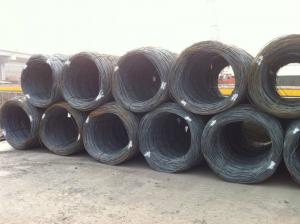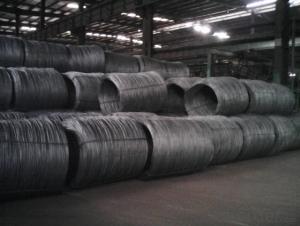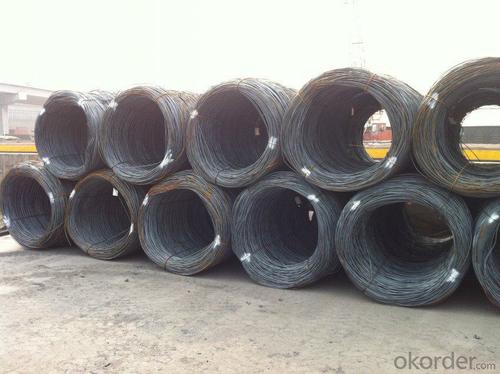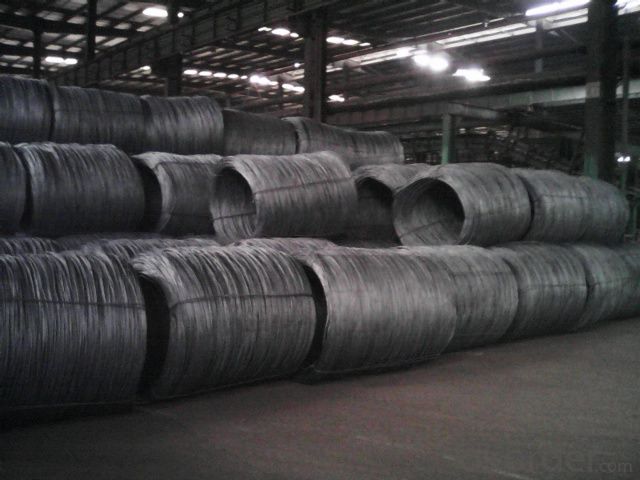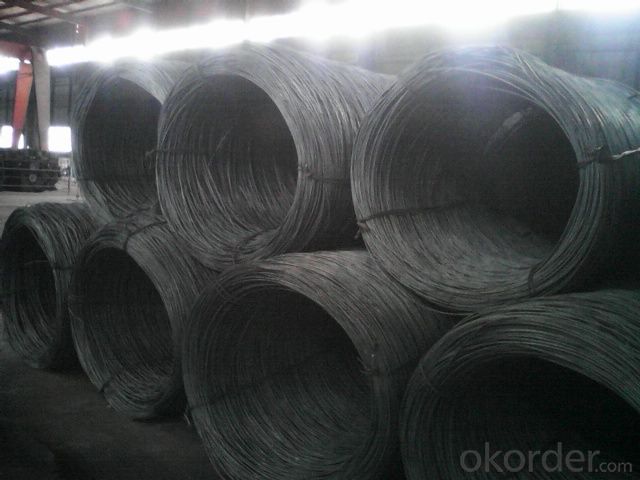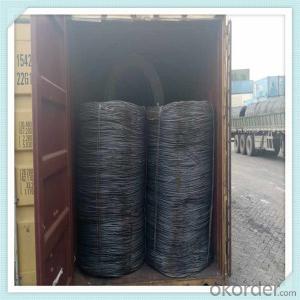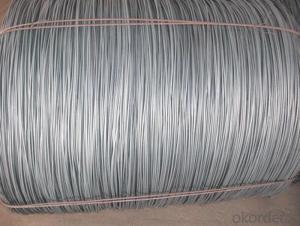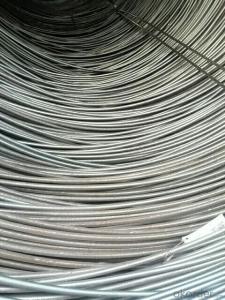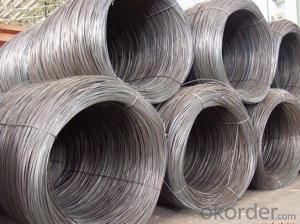GB Hot Rolled Wire Rod 1008b
- Loading Port:
- China Main Port
- Payment Terms:
- TT or LC
- Min Order Qty:
- -
- Supply Capability:
- -
OKorder Service Pledge
OKorder Financial Service
You Might Also Like
Product Description:
OKorder is offering GB Hot Rolled Wire Rod 1008b at great prices with worldwide shipping. Our supplier is a world-class manufacturer of steel, with our products utilized the world over. OKorder annually supplies products to European, North American and Asian markets. We provide quotations within 24 hours of receiving an inquiry and guarantee competitive prices.
Steel Grade: SAE1008B Standard: ASTM, GB
Diameter: 5.5mm, 6.5mm, 7mm,8mm,9mm,10mm,12mm,14mm
Type: Drawn Wire Alloy or Not: Alloy Brand Name: N-RIVER
Technique: Hot Rolled Place of Origin: China Mainland
Chemical Composition:
Please kindly find our chemistry of our material based on SAE1008B as below for your information
Grade | Chemical Composition (%) | |||||
C | Mn | S | P | Si | B | |
SAE1008B | 0.10max | 0.32max | 0.045max | 0.040max | 0.30max | 0.0008min |
Mechanical properties | ||||||
Yield strength(N/mm2) | Tensile strength(N/mm2) | Elongation (%) | ||||
≥195 | 350-380 | ≥32 | ||||
Packaging Detail: products are packed in coil and then shipped by container or bulk vessel
Each coil weight: 2-3MT
Delivery Detail: within 45 days after received deposit or LC.
Label: to be specified by customer, generally, each bundle has 1-2 labels
Trade terms: CFR, CIF
Product Applications:
GB Hot Rolled Wire Rod 1008b are ideal for structural applications and are widely used in the construction of buildings and bridges, and the manufacturing, petrochemical, and transportation industries.
Product Advantages:
OKorder's GB Hot Rolled Wire Rod 1008b 8 are durable, strong, and resist corrosion.
Main Product Features:
· Premium quality
· Prompt delivery & seaworthy packing (30 days after receiving deposit)
· Corrosion resistance
· Can be recycled and reused
· Mill test certification
Product Specifications:
Diameter: 5.5mm, 6.5mm, 7mm,8mm,9mm,10mm,12mm,14mm
FAQ:
Q1: What makes stainless steel stainless?
A1: Stainless steel must contain at least 10.5 % chromium. It is this element that reacts with the oxygen in the air to form a complex chrome-oxide surface layer that is invisible but strong enough to prevent further oxygen from "staining" (rusting) the surface. Higher levels of chromium and the addition of other alloying elements such as nickel and molybdenum enhance this surface layer and improve the corrosion resistance of the stainless material.
Q2: How do we guarantee the quality of our products?
A2: We have established an advanced quality management system which conducts strict quality tests at every step, from raw materials to the final product. At the same time, we provide extensive follow-up service assurances as required.
Q3 Why buy Materials & Equipment from OKorder.com?
A3: All products offered byOKorder.com are carefully selected from China's most reliable manufacturing enterprises. Through its ISO certifications, OKorder.com adheres to the highest standards and a commitment to supply chain safety and customer satisfaction.
Images:
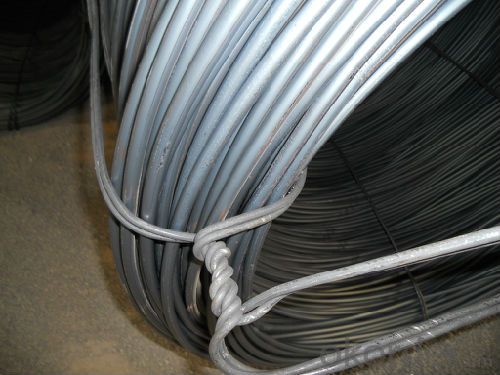

- Q: How is steel wire rod used in the manufacturing of wire rope assemblies for construction purposes?
- Steel wire rod is indispensable in the production of wire rope assemblies for construction purposes. These assemblies are widely employed in construction for a variety of uses, including lifting heavy loads, securing structures, and providing structural support. Steel wire rod acts as the raw material for fabricating the inner and outer strands of a wire rope assembly. These strands are created by intertwining multiple individual wires, resulting in a robust and long-lasting rope. Typically, the wire rod utilized in this process consists of high-quality carbon steel, which imparts the necessary strength and resilience required for construction applications. The manufacturing process commences with the cleaning and lubrication of the steel wire rod to decrease friction during the twisting procedure. Subsequently, the wire rod is drawn through a sequence of dies to decrease its diameter and increase its length. This drawing process aids in aligning the steel's grain structure, thereby improving its strength and flexibility. Once the wire rod has been drawn, it is inserted into a stranding machine where numerous wires are twisted together to form individual strands. These strands are then combined in a specific pattern to construct the wire rope assembly, with the inner strands providing strength and the outer strands offering protection. The wire rope assembly is subsequently subjected to various quality control measures to ensure compliance with the required specifications for construction purposes. These measures may encompass testing for strength, flexibility, and resistance to corrosion. Upon approval, the wire rope assembly is deemed fit for use in construction projects. In the construction industry, wire rope assemblies crafted from steel wire rod find wide-ranging applications. They are frequently utilized in cranes and hoists for lifting heavy loads, offering a secure and dependable lifting solution. Wire rope assemblies are also employed in the construction of suspension bridges, where they provide support and stability. Furthermore, these assemblies are employed for securing structures, such as in the installation of safety barriers or anchoring systems. Overall, steel wire rod plays a pivotal role in the production of wire rope assemblies for construction purposes. Its strength, durability, and versatility make it an ideal material for diverse construction applications, ensuring the safety and dependability of structures and equipment.
- Q: What are the different types of wire mesh for architectural use made from steel wire rod?
- Steel wire rod is used to create several different types of wire mesh for architectural purposes. These options include: 1. Welded Wire Mesh: This wire mesh is formed by welding steel wire rods at their intersection points, resulting in a grid-like pattern. It is commonly utilized for applications such as fencing, partitions, and reinforcement. 2. Woven Wire Mesh: Woven wire mesh is produced by interweaving steel wire rods in an over-and-under fashion. It is known for its strength and durability, and is often employed for architectural screening, decorative panels, and infill panels. 3. Expanded Metal Mesh: By cutting and stretching a sheet of steel wire rod, expanded metal mesh is formed, creating diamond-shaped openings. It is lightweight and provides excellent ventilation and visibility, making it suitable for architectural facades, sunscreens, and walkways. 4. Perforated Metal Mesh: This type of wire mesh is created by punching holes into a sheet of steel wire rod. It offers a variety of hole patterns and sizes, allowing for customization and versatility. Perforated metal mesh is commonly used for architectural cladding, acoustic panels, and decorative screens. 5. Architectural Mesh: Architectural mesh encompasses a range of wire mesh products specifically designed for architectural applications. It can be manufactured using various techniques such as weaving, welding, and expanded metal processes. Architectural mesh is frequently utilized for building facades, sunscreens, balustrades, and interior design elements. All of these wire mesh options, made from steel wire rod and intended for architectural use, possess unique characteristics and can be tailored to meet specific design requirements. They offer strength, durability, and versatility, making them suitable for a wide array of architectural applications.
- Q: What are the common types of internal defects in steel wire rod?
- Some common types of internal defects in steel wire rod include inclusions, segregations, cracks, and voids. Inclusions are foreign substances that are trapped within the steel during the manufacturing process. Segregations occur when the composition of the steel is not uniform, resulting in areas with different properties. Cracks can occur due to excessive stress or improper cooling during production. Voids are empty spaces or cavities within the steel. These defects can weaken the wire rod and affect its overall quality and performance.
- Q: Use of high carbon steel wire rods
- High carbon steel wire rod is made of high quality carbon structural steel. It is one of the larger varieties of wire rod.
- Q: How is steel wire rod used in the manufacturing of wire mesh sieves?
- Steel wire rod is used in the manufacturing of wire mesh sieves as it serves as the raw material for forming the wire mesh. The steel wire rod is first drawn or stretched to the desired thickness and then woven or welded together to create the mesh pattern. This process ensures the strength, durability, and uniformity of the wire mesh sieves, making them suitable for a wide range of applications such as filtration, grading, and particle size analysis.
- Q: How is steel wire rod used in the manufacturing of wire for electrical circuitry?
- Steel wire rod is a vital component in the manufacturing process of wire for electrical circuitry. It serves as the raw material that undergoes various treatments and processes to ultimately become the wire used in electrical circuits. The first step in utilizing steel wire rod is to subject it to a series of mechanical and chemical treatments. This includes processes such as heating, cooling, and drawing, which are aimed at enhancing its strength, flexibility, and conductivity. These treatments ensure that the wire will be able to withstand the electrical current flowing through it without breaking or losing its shape. Once the steel wire rod has been properly treated, it is then shaped into the desired form. This can involve further drawing, twisting, or braiding to achieve the necessary dimensions and characteristics required for electrical circuitry. The wire is often sized to specific diameters and coated with insulating materials, such as enamel or plastic, to prevent short circuits and protect it from external influences. The manufactured wire is then used in various applications within electrical circuitry. It can be employed in the production of electrical cables, where it serves as the conductor that carries the electrical current from one point to another. Additionally, the wire is also used in the construction of transformers, motors, generators, and other electrical equipment. The use of steel wire rod in the manufacturing of wire for electrical circuitry is crucial due to its excellent conductivity, strength, and durability. It ensures the safe and efficient transmission of electricity, while also withstanding the mechanical stress and environmental conditions it may encounter during its use.
- Q: What are the common quality control tests performed on steel wire rod?
- There are several common quality control tests performed on steel wire rod to ensure its compliance with the required specifications and standards. These tests are essential to guarantee the quality and integrity of the wire rod before it is further processed or used in various applications. Some of the common quality control tests performed on steel wire rod include: 1. Chemical Composition Analysis: This test determines the elemental composition of the steel wire rod, such as the percentage of carbon, manganese, phosphorus, sulfur, and other trace elements. It is crucial to ensure that the composition meets the specified limits to ensure the desired mechanical properties and performance of the wire rod. 2. Mechanical Properties Testing: This involves testing the wire rod for its tensile strength, yield strength, elongation, and other mechanical properties. These tests help determine the wire rod's ability to withstand stress, deformation, and other forces without failure or deformation, ensuring its suitability for the intended application. 3. Dimensional Inspection: This test verifies the dimensional accuracy and consistency of the wire rod. It involves measuring the diameter, roundness, and straightness of the wire rod using precision instruments. This ensures that the wire rod meets the specified size and shape requirements, allowing it to be processed or used reliably. 4. Surface Quality Assessment: The surface quality of the wire rod is inspected visually or using magnification to detect any surface defects such as cracks, scales, pitting, or other imperfections. This ensures that the wire rod has a smooth and defect-free surface, which is essential for achieving good adhesion, corrosion resistance, and appearance in the final product. 5. Ultrasonic Testing: Ultrasonic testing is performed to detect any internal defects or discontinuities in the wire rod, such as inclusions, voids, or cracks. This non-destructive testing technique uses high-frequency sound waves to identify any potential flaws that could compromise the wire rod's strength and integrity. 6. Metallurgical Analysis: This test involves examining the microstructure of the wire rod using microscopy techniques. It helps identify the presence of any undesirable phases, grain size, and overall microstructural integrity. This analysis is crucial to ensure that the wire rod has the desired metallurgical properties, such as fine grain size, homogeneity, and absence of any defects that could affect its performance. By conducting these quality control tests on steel wire rod, manufacturers can ensure that the product meets the required standards, specifications, and customer expectations. This, in turn, helps maintain the quality and reliability of the wire rod, ensuring its safe and effective use in various industries such as construction, automotive, and manufacturing.
- Q: How is steel wire rod used in the manufacturing of wire ties for construction sites?
- Steel wire rod is an essential component in the manufacturing of wire ties for construction sites. These wire ties are widely used in the construction industry for various purposes, such as securing rebar, reinforcing concrete structures, and fastening construction materials together. The steel wire rod serves as the raw material for producing wire ties. It undergoes a series of processes to transform it into the final product. First, the wire rod is cleaned and coated to enhance its corrosion resistance. This coating, often made of zinc, provides an added layer of protection against rust and ensures the wire tie's longevity in harsh construction environments. Next, the coated steel wire rod is fed into a wire drawing machine where it is pulled through a die to reduce its diameter to the desired size. This process is repeated several times to achieve the required wire thickness and strength. Once the wire is drawn to the desired gauge, it is then cut into appropriate lengths to produce individual wire ties. These lengths can vary depending on the specific application and requirements of the construction project. The wire is then bent, twisted, or formed into the shape of a tie using specialized machinery. Wire ties made from steel wire rod offer exceptional strength, durability, and flexibility. They can be easily bent or twisted to fit around various construction materials, ensuring a secure and tight connection. Moreover, the high tensile strength of steel wire rod ensures that the wire ties can withstand considerable stress and load without breaking or deforming. The wire ties manufactured from steel wire rod are commonly used in construction sites to secure and fasten rebar during concrete pouring. They are also used to reinforce concrete structures, such as walls, columns, and beams. Additionally, wire ties are employed to bundle or tie together construction materials, including pipes, cables, and electrical wires, ensuring proper organization and preventing potential hazards. In summary, steel wire rod plays a crucial role in the manufacturing of wire ties for construction sites. These wire ties provide essential support and reinforcement in various construction applications, offering durability, flexibility, and strength to ensure the safety and stability of construction projects.
- Q: What are the main factors affecting the market diversification of steel wire rod?
- The main factors affecting the market diversification of steel wire rod include fluctuations in global demand for steel products, changes in market dynamics and trends, advancements in technology and production processes, regulatory and trade policies, competition from alternative materials, and consumer preferences and requirements.
- Q: How is steel wire rod used in the production of tire reinforcement materials?
- Steel wire rod is used in the production of tire reinforcement materials as it provides strength and durability to the tires. The wire rod is typically twisted or braided together to form steel cords, which are then embedded in the tire's rubber compound. These steel cords help to improve the tire's strength, stability, and resistance to punctures, ensuring a safer and more reliable performance on the road.
Send your message to us
GB Hot Rolled Wire Rod 1008b
- Loading Port:
- China Main Port
- Payment Terms:
- TT or LC
- Min Order Qty:
- -
- Supply Capability:
- -
OKorder Service Pledge
OKorder Financial Service
Similar products
Hot products
Hot Searches
Related keywords
